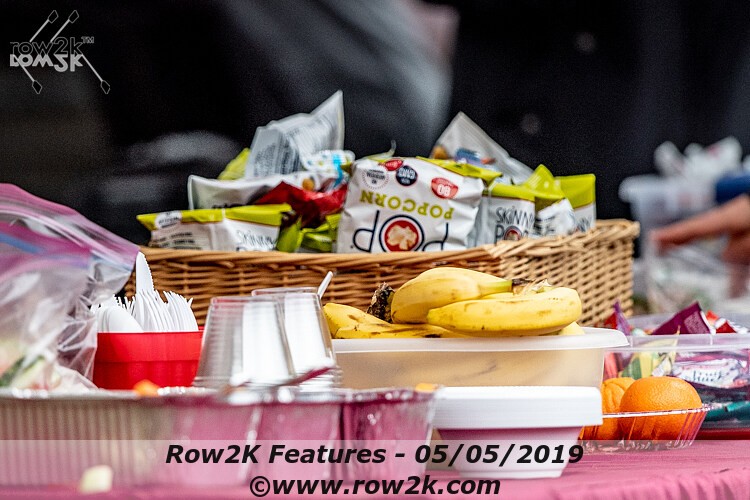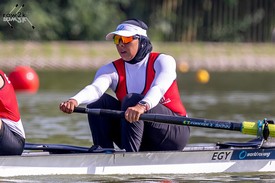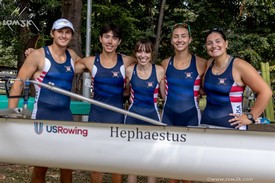
Training and racing in sports burns calories - so many that athletes need to make sure they are putting back as many as they are draining out during both practice and competition, and keeping their bodies properly fueled.
Not every athlete has access to a nutritionist to set guidelines that help educate rowers on how much to eat, when to eat, and what are the best ways of being nutritionally prepared for both race days and periods of high-volume training.
So row2k asked US national team performance dietitian Liz Fusco for some suggestions about what to eat when training, what and when to eat on race days, and if there is a significant difference in the nutritional needs of high school athletes vs collegiate and elite rowers.
row2k: Is there a difference in what athletes should be consuming from one season to the next, from winter and early spring, to race days?
Fusco: Absolutely. It all gets back to fueling in accordance with your effort level, meeting the demands of training through what you are consuming. The question of whether there should be a difference in how much, or what, you eat between the winter and spring is really a question of how much volume are you doing.
Generally, athletes are doing a higher volume of training in the winter, but not quite as much total volume in the spring, and during the racing season. So, consciously increasing their carbohydrate consumption around training sessions, maybe even during long training sessions, becomes important in the winter time, because the energy demand tends to be high.
During the racing season, it's still including carbohydrates, but the focus is really on eating frequently enough throughout the day, as frequently as you would when you are doing higher volume. There is just a little bit of a nutrient adjustment when you are doing more racing style stuff.
row2k: What is a good nutrition plan?
Fusco: What I like to do with athletes is to have them sort of lay a foundation of frequency of eating, so that basically every three or four hours you should be eating either a meal or a balanced snack.
That might shift around a little bit based on when you wake up in the morning. Maybe sometimes you are waking up at five and going to bed at 10 PM, so you should be eating more often. On those days when you have an off day, and you are waking up at 10 or 11, you adjust so you are consistently fueling to meet the demands of training.
row2k: What is a good race day plan?
Fusco: Leading up to race days, there tends to be a bit of a taper, where the athletes aren't doing as much exercise. So, it's important for them to eat as often, but they may not need to eat as much total volume of food, they may not need to eat many total calories.
Keeping the consistency on race days can be challenging. But, generally, on race days, the goal is to keep it simple and familiar - eating things that athletes know they can tolerate well before. The general consensus in the sports nutrition world is, maybe in the hour or two before you have a race, you might limit the amount of fiber you are consuming, and the amount of total fat you are consuming.
An example would be if you only have an hour before you race, rather than having a big oatmeal bowl with peanut butter and nuts, things that will take a long time to digest, you might shift and have something more like a fruit based smoothie, made with milk or yogurt, something that's drinkable and going to be digested a little bit faster.
By doing that you reduce your risk of having GI issues when you are racing and you also get a little bit faster energy provision for the actual event. So, on race days, it's consistency of eating, making sure nerves aren't preventing you from eating, and eating as often as you should, and just keeping it simple.
row2k: Is there a difference between the needs of high school aged athletes vs those of collegiate and elite athletes?
Fusco: It does vary. Because with high school athletes, and this isn't always true, but generally, they are still growing and they tend to not be doing as much volume as collegiate and elite level athletes are.
So, the recommendation for high school age athletes - 13, 14, 15 and 16 - is they don't need quite as many total calories as a full-grown adult would. They don't need quite as much of the macro-nutrients.
But the basic principles are the same, they should still be eating frequently. They should still be having sources of all the different nutrients and they should still be eating more when they are working harder.
To help better understand nutritional needs, suggestions for meals, and a resource for a better understanding of good nutritional practices for athletes, Fusco suggest visiting the United States Olympic Committee nutrition page on Team USA.org
If you enjoy and rely on row2k, we need your help to be able to keep doing all this. Though row2k sometimes looks like a big, outside-funded operation, it mainly runs on enthusiasm and grit. Help us keep it coming, thank you! Learn more.
Comments | Log in to comment |
There are no Comments yet
| |
- Bont Rowing
- Calm Waters Rowing
- Concept 2
- Craftsbury Sculling
- The Crew Classic
- CrewLAB
- Croker
- Durham Boat Co.
- Empacher
- Faster Masters
- Filippi
- Fluidesign
- h2row.net
- HUDSON
- Live2Row Studios
- Nielsen-Kellerman
- Oak Ridge RA
- Peinert Boat Works
- Pocock Racing Shells
- Race1 USA
- RowKraft
- Rubini Jewelers
- Vespoli USA
- WinTech Racing
- Bont Rowing
- Calm Waters Rowing
- Concept 2
- Craftsbury Sculling
- The Crew Classic
- CrewLAB
- Croker
- Durham Boat Co.
- Empacher
- Faster Masters
- Filippi
- Fluidesign
- h2row.net
- HUDSON
- Live2Row Studios
- Nielsen-Kellerman
- Oak Ridge RA
- Peinert Boat Works
- Pocock Racing Shells
- Race1 USA
- RowKraft
- Rubini Jewelers
- Vespoli USA
- WinTech Racing

















